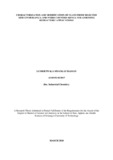| dc.description.abstract | Clay is a stony or earthy mineral aggregate composed of fine-grained minerals, which are plastic at appropriate water content and hardens up when fired. Uses of clay include manufacture of cement, ceramics, bricks, drilling clays, paints, fillers in paper industry and for refractory production. Refractories are materials that withstand high temperatures and are comprised of oxides with high melting temperature such as Al2O3, SiO2, ZrO, Cr2O3, and MgO. Clay deposits have been reported in Kenya in areas such as Kano plains, Mwea, Chavakali and Ilesi. Murang’a and Nyeri counties are also two of such areas with clay deposits. Despite the abundance of clay, Kenya still imports both clay products and raw clays for industrial use, clay worth 3 billion Kenya shillings was imported in 2013. This project intended to determine the elemental and mineralogical composition of clays from Murang’a and Nyeri counties to determine whether they can be used for refractory applications. Futhermore, the study determined the effect of acid washing and addition of CaO on the refractory properties of clays. Most of Kenyan clays are used for ceramics and cement manufacture.The samples of clays used in this study were obtained from Githima (0° 46´ 40´´ S and 37º 6´ 31´´ E), Kimathi Sampling site (0º 40´ 0´´ S and 37º 10´ 28´´ E) and Ithanje Sampling site (0º 36´ 30´´ S and 37º 6´ 46´´ E). Elemental and mineralogical composition were determined using Atomic Absorption Spectrophotometer and X-Ray Diffraction respectively. The clays were leached using hydrochloric and oxalic acid separately at concentration of 0.0, 0.1, 0.25, 0.5, 1, and 2 M. The clay was blended with 0, 1, 2, 5, 15 and 30 % of CaO. The raw, acid-treated and clays containing CaO were moulded into blocks (8x4x4 cm) followed by air and oven drying then fired in a furnace at 1000 ºC. The fired bricks were tested for apparent porosity, bulk density, linear shrinkage, and refractoriness. The major components of the raw clays when expressed as oxides were 40.80-55.40 % SiO2, 16.27-30.33 % Al2O3, 0.62-7.62 % TiO2, 0.84-2.65 % K2O, 0.02-1.82% MgO. Elemental composition of the acid treated clays, in oxide form were in the ranges of 40.80-65.16 % SiO2, 7.16 -30.33 % Al2O3, 0.33-7.62 %TiO2, 0.24-2.65 % K2O, 0.01-1.82 % MgO. Refractory properties of the raw clays were in the ranges 26.31-31.33 % apparent porosity, 1.56-1.68 g/cm3 bulk density, 1-3 % linear shrinkage, and 1609-1686 °C refractoriness. Refractory properties of the acid treated clays were in the ranges of 21.65-35.1 % apparent porosity, 1.32-1.76 g/cm3 bulk density, 1-3.62 % linear shrinkage, and 1575-1686 °C refractoriness. Refractory properties of CaO added clays were in the ranges of 22.16-31.33 % apparent porosity, 1.56-2.8 g/cm3 bulk density, 0.8-3.3 % linear shrinkage, and 1579-1686 °C refractoriness. These clays meet certain aspects of refractory materials. However, they require enhancement through acid treatment and CaO addition to meet requirements for refractory application. Proper utilization of findings from this study would improve Kenya’s industrialization and economic diversification. | en_US |

